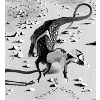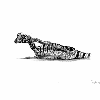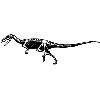| “double-crested lizard” |
CLASSIFICATION
| Dilophosaurus Welles, 1970TYPE SPECIES: D. wetherilli (Welles, 1954) (originally Megalosaurus) OTHER SPECIES: D. breedorum Welles, 1995 vide Welles & Pickering, 1999 “The Breeds’ (including William J.) double-crested lizard” ?D. sinensis Hu, 1993 “double-crested lizard from China” | Animalia Vertebrata Tetrapoda Sauropsida Archosauromorpha Ornithodira Dinosauria Sauropodomorpha |
see also: Genus Index, Classification
MEASUREMENTS
TIME
late Sinemurian to Pliensbachian
see also: Ages of the Mesozoic
PLACE
D. wetherilli: Arizona
D. breedorum: Arizona
D. sinensis: China
REMAINS
- D.wetherilli
- D.breedorum
- UCMP 77270:
- D.sinensis
ESSAY
| Dilophosaurus sported a pair of thin crests running from above the nostrils to the back of the head. (At least, D. breedorum [which may very well be a junior synonym of D. wetherilli] and D. sinensis did — that part of the skull is unknown for D. wetherilli sensu stricto.) These frills were probably ornamental in nature. Dilophosaurus was featured in the blockbuster movie Jurassic Park. Considerable liberties were taken with the restoration. Real Dilophosaurus were much larger than their Jurassic Park counterparts. There is no evidence that they had neck frills or poison glands. In fact, Dilophosaurus was the largest predator in its environment and had no need to be poisonous. Furthermore, Jurassic Park’s dilophosaurs had jaws simplified beyond recognition (the cool kink was utterly smoothed out). D. sinensis had taller, more robust crests. It may not belong to this genus. |
IMAGES
Click on thumbnail to see full image.

| Sporting breeding colors, a Dilophosaurus wetherilli displays to potential mates. |


